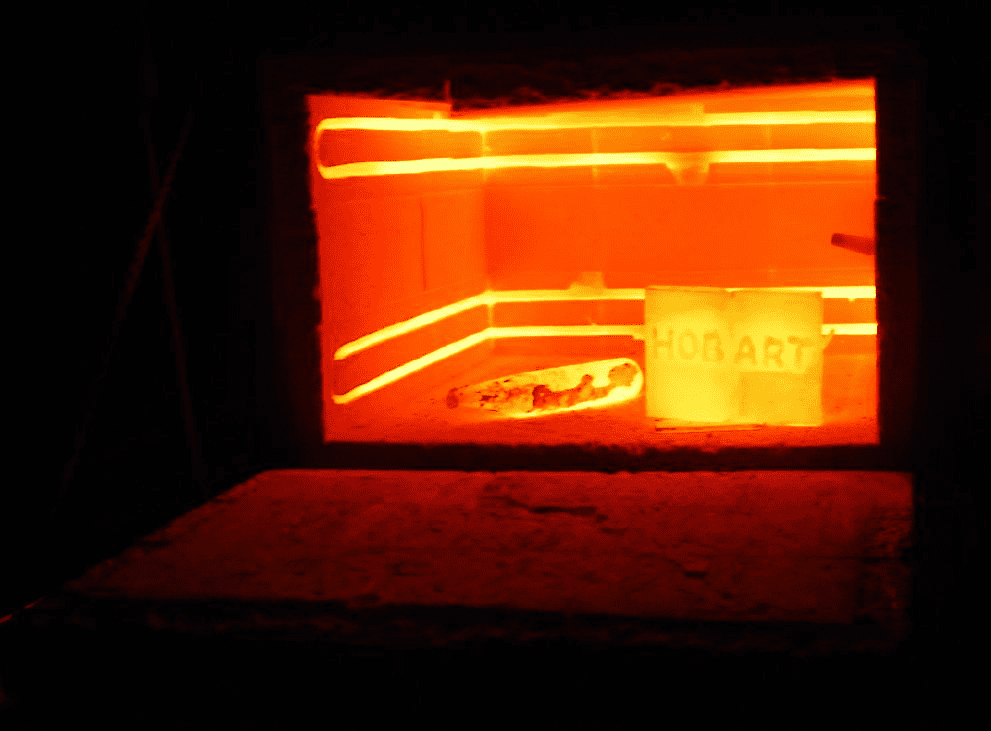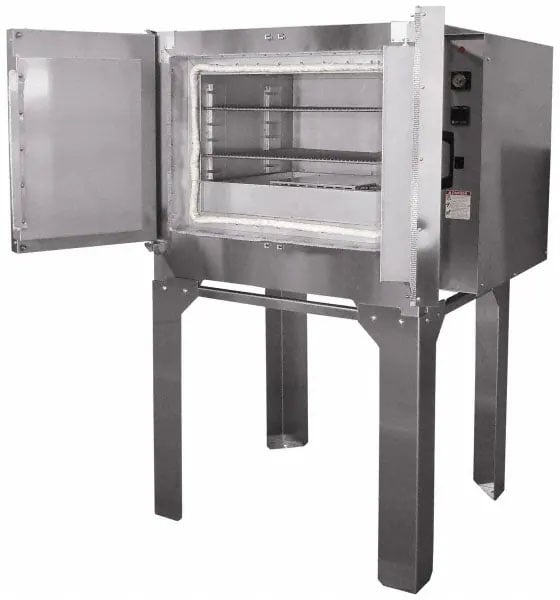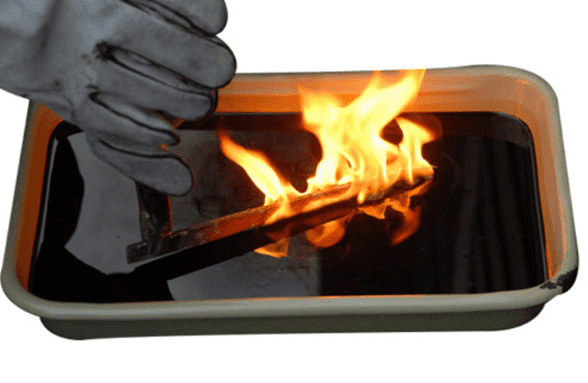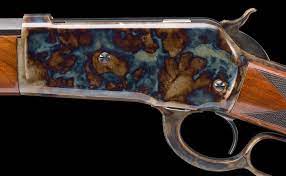What is Heat Treatment of Metals?
Heat Treatment of metals is a manufacturing process that uses heat to modify the mechanical properties of a material, such as steel. Nearly every metal involved in manufacturing goes through some sort of heat treatment. Humans have been doing heat treatment for thousands of years.
Heat treating can soften, harden, improve formability, increase corrosion resistance, increase abrasion resistance, and toughen brittle materials.

By Ichudov - Own work, CC BY-SA 3.0, https://commons.wikimedia.org/w/index.php?curid=6588690
Heat treated parts are used almost anywhere wear resistance and strength are called for. It is popular in automotive, aerospace, computers, and heavy equipment. The parts particularly subject to stress such as cutting tools, bearings, gears, axles, fasteners, camshafts, and crankshafts all depend on heat treatment.
Although iron and steel account for the vast majority (80%) of heat treated metals, alloys of aluminum, copper, magnesium, nickel, and titanium are also often heat treated.
Heat treatments add about $15 billion a year in value to metal products. If you're a machinist or engineer designing metal products, you'll find knowledge of heat treatment essential. The ASM heat treating society is dedicated to the advancement of heat treatment.
Heat Treatment Processes

The Heat Treatment Process involves consists of 3 heat treatment stages:
- Heating
- Soaking
- Cooling process
Heating
Heating is the first stage of the heat treatment process. The metal or alloy is brought to some specific temperature. Usually that temperature is the Critical Temperature. The critical temperature is also known as the Normalizing Temperature.
The key temperature transformation points in heat treatment are:
- Normalizing Temperature: Austenite phase is where other structures are formed. Most heat treatments begin by heating steel to a uniform austenitic phase of 1500-1800F.
- Upper critical temperature: This is the point below which cementite or ferrite begin to form. It occurs while steel is cooling from the normalizing temperature. It occurs from 1333-1670F.
- Lower critical temperature: This is the point of austenite to pearlite transformation. Austenite cannot exist below a lower critical temperature of 1333F.
Heating is done in a Heat Treatment Oven, which is similar to a pottery kiln:

Soaking
Soaking is keeping the metal at the target temperature for a specific length of time so that its structure may be completely changed. The greater the mass of material being heat treated, the longer it will be soaked.
Cooling
Cooling is the third and final stage of heat treatment. It also changes the structure of the material. Cooling may be accomplished by quenching (dropping the material in some liquid at a lower temperature so it is cooled quickly) or letting it rest in still air for slow cooling.
Heat Treatment Types
This section considers the various heat treatment techniques that may be applied in specific heat treatment recipes. A good heat treating shop can do all of these things to give metals the desired properties specified by their designers.
Fundamentally, there are 4 kinds of heat treatment:
- Annealing: Aimed at making the material more workable.
- Normalizing: Similar to annealing but done at room temperature.
- Hardening: Used to make materials harder.
- Tempering: Tempering is done right after quenching. Tempering relieves stresses induced by quenching, lowers hardness to a specific range, and can improve a variety of other mechanical properties.
Let's describe each heat treatment process in turn:
Annealing Process
Annealing is a heat treatment process that changes the physical and sometimes the chemical properties of a material to increase ductility and to make the material more workable. It's not uncommon to anneal the raw material before machining, for example.
To anneal, raise the material above its recrystallization temperature for a set amount of time (soaking time) and then cool. The cooling rate will depend on what kind of material is being annealed.
For example, ferrous metals are cooled slowly to room temperature via still air cooling. Copper, silver, and brass can either use still air cooling or be quickly quenched in water.
We can further identify three stages of annealing:
- Recovery: Raise to temperature enough to relieve internal stresses.
- Recrystallization: Raise the temperature further until it is above the recrystallization temperature, but below the materials melting point.
- Grain Growth: Grains will develop as the material is cooled at a specific rate. This is what causes the material to be more workable-less hard and less brittle.
Annealing may be called for to reverse Work Hardening. If materials are too hard, they are difficult to further work and they may crack.
Annealing can also remove stresses that occur as welds solidify. And it may improve magnetic properties and electrical conductivity.
Hardening Process
The hardening heat treatment process is used to make materials harder (duh!). It is done by heating the material to Critical Temperature, holding that temperature for 1 hour per inch of thickness, and then cooling at a rate that allows to material to harden to a much stronger tougher structure.
Quenching
Quenching is a heat treatment process where the material is cooled rapidly.

Quenching in Oil. Courtesy of Valvoline...
After a material has been heated up it may be quenched in water or oil to harden it to the maximum. Parts that are quenched are never used until after they've been aged, tempered, or stress relieved to further improve and fine tune their final properties. If nothing else, quenching can introduce lots of internal stresses which can lead to parts warping.
Stress Relieving
Parts which have been heavily formed, machined, cut or welded will have internal stresses. Internal stress can cause the material to bend or warp over time. heat treating can make these parts stress free by heating (thermal relaxation) and holding until the stress is relieved.
Typically, stress relieving is done by heating the part to about 75F below the transformation temperature. Hold that temperature for one hour per inch of part thickness.
Heat treating parts for stress relief may be needed just to ensure parts can be accurately machined to start with.
Normalizing
Normalizing is similar to annealing, but annealing is done in a furnace while normalizing uses air cooling. To Normalize, bring the material to the correct temperature, let it Soak for 10-20 minutes, then let it cool freely in still air to room temperature.
Normalizing is done to refine the grain size of the material. This improves the mechanical properties of plain carbon steels. Normalizing will increase ductility and toughness. Where applicable, it is preferred over hardening and tempering because it is simpler and therefore cheaper.
Compared to annealing, normalization does the following:
- Faster cooling rate
- Greater mechanical strength and hardness
- Better machinability. Annealing makes materials too soft for good chip breaking.
- Less ductility than for annealing.
- Less expensive than annealing.
We can normalize the following materials:
- Iron alloys like carbon stell, stainless steel, cast iron, etc..
- Nickel alloys
- Copper
- Aluminum
- Brass
Tempering
Tempering is done right after quenching. Steels are almost never used in quenched condition. Tempering relieves stresses induced by quenching, lowers hardness to a specific range, and can improve a variety of other mechanical properties.
We temper by reheating at relatively low temperatures to fine tune the microstructure of the material. The exact temperature and time must be tightly controlled based on the material.
Carburizing and Case hardening
In this heat treatment process, the surface is made more resistant to wear while leaving the core of the part alone. It works by diffusing carbon into the surface of the steel, so it is a surface hardening process. The core will be substantially less hard.
Carburizing and Case Hardening is usually done in a furnace by introducing gasses that contain carbon. This is done at a controlled temperature and for a time that ensures proper penetration.
After carburizing, the work is either slow cooled or quenched directly.

Color case hardening a rifle...
Case hardening is an older term most commonly associated with firearms. The colors from it can be a beautiful effect that makes a classic firearm all the more desirable.
Precipitation Strengthening
Precipitation strengthening or the precipitation hardening process (also called age hardening) is a heat treatment process where a second phase that begins in solid solution with the matrix metal is precipitated out of solution with the metal as it is quenched, leaving particles of that phase distributed throughout to cause resistance to slip dislocations.
This is achieved by first heating the metal to a specific temperature where the elements forming the particles are soluble then quenching it, trapping them in a solid solution.
After the precipitation hardening process, a second heat treatment is required to age the material.
Heat Treatment Glossary
Annealing
A process of heating and slowly cooling metal, typically steel, to remove internal stresses. This procedure makes the metal softer and can alter its ductility.
Carburizing
A technique to add carbon to the surface of an iron alloy part by heating it below its melting point (usually between 1,560°F and 1,740°F) and exposing it to carbon-rich materials. This process strengthens the metal, hardens its surface, and increases abrasion resistance, but it also reduces toughness. Carburizing is generally performed on finished parts.
Case Hardening
A method of hardening an iron alloy part by carburizing it and then quenching to lock in the changes within the alloy's structure. This results in a part with a hard outer layer and a relatively soft core.
Cyanide Hardening
A variation of case hardening where the part's surface is exposed to molten cyanide salt and then quenched. This hardens the surface while maintaining a softer interior.
Decarburization
The removal of carbon from the surface of steel by applying heat or through natural oxidation over time.
Drawing (Tempering)
After hardening, the metal is reheated to a specific temperature and then quenched. This process reduces hardness while increasing toughness.
Nitriding
A hardening process that adds nitrogen to the surface of the metal by exposing it to ammonia gas. This creates case-hardened parts without the need for quenching.
Precipitation Hardening
Also known as age hardening, this process involves holding the metal part at elevated temperatures without quenching. It increases the yield strength of malleable materials like aluminum, magnesium, nickel, titanium, and some stainless steels. In superalloys, it enhances high-temperature strength.
Quenching
A rapid cooling process for steel or other metals, typically by immersing them in oil or water. This step fixes the metal's structure in a hardened state and is often the final stage in hardening procedures.
Spheroidizing
A heat treatment method to increase the amount of rounded or globular carbide in steel. This process softens the steel and improves its ductility.
Cold Working
A non-heat-treating process that alters a metal's properties by deforming it at room temperature without causing fractures. This enhances the metal's tensile strength and machinability.
Frequently Asked Questions (FAQs)
What are the 4 types of heat treatment?
There are 4 kinds of heat treatment:
- Annealing: Aimed at making the material more workable.
- Normalizing: Similar to annealing but done at room temperature.
- Hardening: Used to make materials harder.
- Tempering: Tempering is done right after quenching. Tempering relieves stresses induced by quenching, lowers the hardness to a specific range, and can improve a variety of other mechanical properties.
What is the heat treatment process?
Heat treatment involves the use of heating or chilling to extreme temperatures to achieve the desired result such as hardening or softening of a material.
What is heat treating used for?
Heat treating can improve wear resistance by hardening the material.
What does quenching do?
Quenching is the rapid cooling of the material by immersion in oil or water. It is undertaken to maintain mechanical properties associated with the crystalline structure that would be lost upon slow cooling.
Conclusion
Heat treatment as a manufacturing process can make parts hugely more durable and suited to task. It can make them much easier to work during manufacture. Selecting the right heat treatment processes requires some expertise. We've giving you the basic terminology and framework for what's passible. You should be able to select heat treatment processes based on that, or at least understand the conversation with a heat treatment shop to get your parts properly heat treated.
On the other hand, we haven't given enough detail to actually perform heat treatment manufacturing processes. Heat treating methods must be carefully controlled and the specified temperature of each step and times must be precisely managed. Heating and cooling require just the right conditions. Just knowing what the right parameters are for heat treated materials is a daunting task. Most shops rely on an outside heat treatment shop for a proper heat treatment process that satisfies their heat treatment needs.
Heat Treated Metals are here to stay.
Be the first to know about updates at CNC Cookbook
Join our newsletter to get updates on what's next at CNC Cookbook.